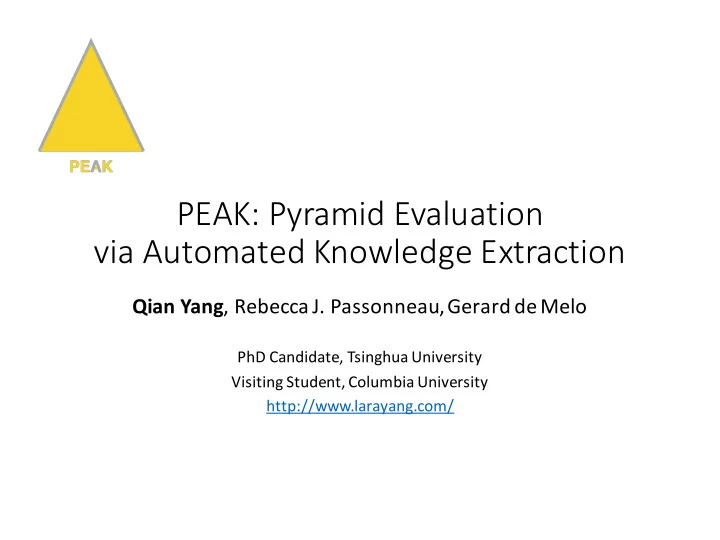

PEAK: Pyramid Evaluation via Automated Knowledge Extraction Qian Yang , Rebecca J. Passonneau, Gerard de Melo PhD Candidate, Tsinghua University Visiting Student, Columbia University http://www.larayang.com/
Content • Evaluating Summary Content • Our Contribution • How does PEAK work? – Semantic Content Analysis – Pyramid Induction – Automated Scoring • Our Results • Conclusion
Content • Evaluating Summary Content • Our Contribution • How does PEAK work? – Semantic Content Analysis – Pyramid Induction – Automated Scoring • Our Results • Conclusion
Evaluating Summary Content • Human assessors – Judge each summary individually – Very time-consuming and does not scale well • ROUGE (Lin 2004) – Automatically compares n-grams with model summaries – Not reliable enough for individual summaries (Gillick 2011) • Pyramid Method (Nenkova and Passonneau, 2004) – Semantic comparison, reliable for individual summaries – Has required manual annotation
Content • Evaluating Summary Content • Our Contribution • How does PEAK work? – Semantic Content Analysis – Pyramid Induction – Automated Scoring • Our Results • Conclusion
Content • Evaluating Summary Content • Our Contribution • How does PEAK work? – Semantic Content Analysis – Pyramid Induction – Automated Scoring • Our Results • Conclusion
Our Contribution • No need for manually created pyramids • Also good results on automatic assessment given a pyramid
Content • Evaluating Summary Content • Our Contribution • How does PEAK work? – Semantic Content Analysis – Pyramid Induction – Automated Scoring • Our Results • Conclusion
Content • Evaluating Summary Content • Our Contribution • How does PEAK work? – Semantic Content Analysis – Pyramid Induction – Automated Scoring • Our Results • Conclusion
Content • Evaluating Summary Content • Our Contribution • How does PEAK work? – Semantic Content Analysis – Pyramid Induction – Automated Scoring • Our Results • Conclusion
Semantic Content Analysis Source: http://www1.ccls.columbia.edu/~beck/pubs/2458_PassonneauEtAl.pdf
Semantic Content Analysis Weight : 4 Figure 1: Sample SCU from Pyramid Annotation Guide: DUC 2006 .
Semantic Content Analysis • “ The law of conservation of energy is the notion that energy can be transferred between objects but cannot be created or destroyed. ” • Open information extraction (Open IE) methods split them and extract <subject,predicate,object> triples
Semantic Content Analysis • “ These characteristics determine the properties of matter ” yields the triple ⟨ These characteristics , determine , the properties of matter ⟩ • We use ClausIE (Del Corro and Gemulla 2013)
Semantic Content Analysis Figure 2: Hypergraph to capture similarites between elements of triples, with salient nodes circled in red Similarity Score : Align, Disambiguate and Walk (ADW) (Pilehvar, Jurgens, and Navigli 2013),
Content • Evaluating Summary Content • Our Contribution • How does PEAK work? – Semantic Content Analysis – Pyramid Induction – Automated Scoring • Our Results • Conclusion
Content • Evaluating Summary Content • Our Contribution • How does PEAK work? – Semantic Content Analysis – Pyramid Induction – Automated Scoring • Our Results • Conclusion
Pyramid Induction
Pyramid Induction
Pyramid Induction
Content • Evaluating Summary Content • Our Contribution • How does PEAK work? – Semantic Content Analysis – Pyramid Induction – Automated Scoring • Our Results • Conclusion
Content • Evaluating Summary Content • Our Contribution • How does PEAK work? – Semantic Content Analysis – Pyramid Induction – Automated Scoring • Our Results • Conclusion
Scoring – Pyramid Method • Score a target summary against a pyramid – Annotators mark spans of text in the target summary that express an SCU – The SCU weights increment the raw score for the target summary. • An Example – SCU Label: Plaid Cymru wants full independence – Target Summary: Plaid Cymru demands an independent Wales
Automated Scoring – PEAK
Content • Evaluating Summary Content • Our Contribution • How does PEAK work? – Semantic Content Analysis – Pyramid Induction – Automated Scoring • Our Results • Conclusion
Content • Evaluating Summary Content • Our Contribution • How does PEAK work? – Semantic Content Analysis – Pyramid Induction – Automated Scoring • Our Results • Conclusion
Dataset • Student summary dataset from Perin et al. (2013) with 20 target summaries written by students • Passonneau et al. (2013) had produced 5 reference model summaries , and 2 manually created pyramids
Results
Results
Result • Machine-Generated Summaries – Dataset: the 2006 Document Understanding Conference (DUC) administered by NIST (“DUC06”) – The Pearson’s correlation score between PEAK’s scores and the manual ones is 0.7094.
Content • Evaluating Summary Content • Our Contribution • How does PEAK work? – Semantic Content Analysis – Pyramid Induction – Automated Scoring • Our Results • Conclusion
Content • Evaluating Summary Content • Our Contribution • How does PEAK work? – Semantic Content Analysis – Pyramid Induction – Automated Scoring • Our Results • Conclusion
Conclusion • The first fully automatic version of the pyramid method • Not only evaluates target summaries but also generates the pyramids automatically • Experiments show that – Our SCUs are similar to those created by humans – The method for assessing target summaries automatically has a high correlation with human assessors
• Overall, our research shows great promise for automated scoring and assessment of manual or automated summaries, opening up the possibility of wide-spread use in the education domain and in information management.
This data and codes are available at http://www.larayang.com/peak/. Thank you!
Recommend
More recommend